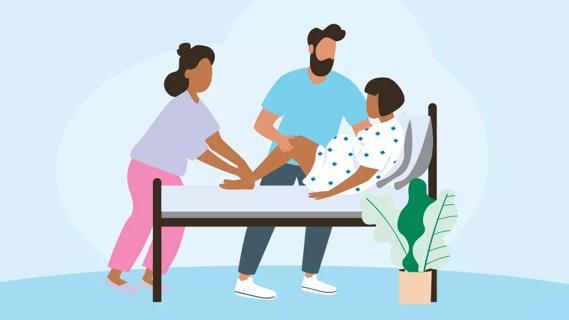Lamaze birthing techniques — like breathing during labor and bonding after birth — are among the most commonly taught methods in childbirth prep classes

If you hear the word “Lamaze” and immediately think of sitcoms and movies of the 1980s and '90s, you’re not alone.
Advertisement
Cleveland Clinic is a non-profit academic medical center. Advertising on our site helps support our mission. We do not endorse non-Cleveland Clinic products or services. Policy
Lamaze has become synonymous with that “hee-hee-hoooo” breathing rhythm that is akin to a soundtrack of labor and delivery from decades ago.
But many practices taught in the Lamaze classes of yore are still around today as evidence-based childbirth preparation techniques. And while breathing techniques are part of a Lamaze practice, breathwork is just one part of the equation.
“I encourage everyone who’s pregnant to take a childbirth preparation class. And much of the advice and education you get in standard birthing classes are closely related to the concepts taught in Lamaze,” says certified nurse midwife Tamara Noy, MSN, CNM.
What are the principles of Lamaze, and how are they relevant to today’s best practices in labor and delivery? Noy explains.
Lamaze is an approach to childbirth education that’s been around since the 1960s, founded by Dr. Fernand Lamaze.
It was the gold standard for past generations to take specific Lamaze classes before their due dates. These days, the Lamaze name itself doesn’t show up as much. But many lessons shared in those classes have been incorporated into today’s mainstream childbirth courses.
So, when you take a birthing class at your local hospital or birth center, chances are, you’re learning many of the evidence-based concepts that are foundational to Lamaze.
Advertisement
“Most hospitals and birth centers offer childbirth classes, including subsets of birthing options, like hypnobirthing or the Bradley method,” Noy shares. “But the basis of your typical birth prep class is essentially Lamaze. It’s still based on a lot of those same principles but with more wiggle room and caveats.”
Lamaze and other childbirth prep classes will likely encourage many of the same practices. But your hospital’s childbirth class may be more flexible when appropriate.
Let’s look at the cornerstones of Lamaze to understand where your hospital’s practices may be similar and where you may see differences.
The first tenant of Lamaze is that labor should begin on its own. That means avoiding induced labor or pre-planned C-sections unless medically necessary.
When that’s possible without posing a risk to you or the fetus, that should be the goal for your healthcare team, too.
The philosophy of Lamaze, and best practices in labor and delivery practice in general, are to allow labor to come on its own when it’s safe to do so. Spontaneous labor can help your labor progress faster and may be safer for you and the fetus.
But it’s not always possible.
Even the best plans can change. That’s OK. Sometimes, induced labor or a C-section are the better route to a healthy labor and delivery. It’s a matter of weighing the risks.
If your healthcare provider recommends an induced labor or C-section, they should be prepared to share why that’s the better option for you. Don’t hesitate to ask questions and make an informed decision in collaboration with your provider.
Lamaze educators and generally accepted medical guidelines encourage women in labor to get a move on. Literally.
That’s because moving can encourage the fetus to progress through the birth canal and get into birthing position.
“A lot of people don’t realize how important movement is during labor,” Noy notes. “But movement can make a real difference in how your labor progresses.”
Changing positions can also help reduce discomfort during contractions.
Try these methods to get moving during labor:
You may be the one giving birth, but that doesn’t mean you have to go at it alone. The principles of Lamaze and best practices in birthing education encourage having a labor support person on your side.
That could mean:
Your dedicated labor support person should be prepared to be your rock during labor and delivery. That can mean things like:
Advertisement
This is where you’ll find some of the biggest differences between Lamaze principles and other accepted wisdom in childbirth education.
The principles of Lamaze discourage interventions unless they’re medically necessary. For example, most Lamaze educators don’t support measures like:
But your hospital or birth center may have policies that run counter to these principles.
For example, it’s typical for most to not allow food or drink during labor. And fetal monitoring may be recommended.
As for pain medication, that’s a standard option in most labor and delivery rooms.
“Traditional Lamaze approaches encourage medication-free labor whenever possible,” Noy reports. “But whether you choose an epidural or other pain relief options should be your choice. And your healthcare team should respect and support your wishes, regardless of which route you choose.”
Advertisement
It’s the emphasis on a medication-free birth that led to Lamaze getting its reputation for that pant-pant-blow breathing technique. (That is, exhaling with two short pants followed by one longer blow.)
Lamaze practitioners encourage dedicated breathing techniques like this to help lessen the discomforts of labor and promote a medication-free birth.
Other childbirth education programs may encourage other forms of breathwork and relaxation techniques to help manage contractions. And they’re very likely to discuss epidurals and other pain relief medication as an option during your labor.
TV and movies may have you believing that when it’s time to push, you’ll be reclined on your back with your feet in the stirrups.
Lamaze philosophy and typical childbirth guidance say that doesn’t have to be the case.
When it comes to birthing positions, you have options. And reclined on the bed might not be the best one. Lamaze educators will say it should be avoided. But other childbirth prep courses could be more flexible.
Delivery positions may include:
What’s the best position for you to give birth? Well, as with so many things when it comes to a safe and healthy birth, it depends.
Advertisement
If you’ve had an epidural, for example, you may not be able to get onto all fours without some significant support. If there's a need for continuous fetal monitoring, there may be wires in the way that limit your options, too.
“As you prepare for giving birth, knowing some different birthing positions is important. That way, when the time comes, you can know something about what to expect and be ready to get into a position that works for you and for the fetus,” Noy advises.
Maybe that’s reclined on the bed. Maybe it’s not. But the thing to know is that you can (and should) have some wiggle room (literally).
Many hospitals these days have done away with the idea of a nursery for newborns. Today’s policies are more likely to encourage baby to stay in the room with you when possible while you’re at the hospital or birth center.
That’s a core practice in Lamaze, too.
So, is the idea of skin-to-skin contact (“kangaroo care”) immediately after birth, which is standard in most hospital settings. That is, as long as it’s safe for you and baby.
Lamaze educators will say that keeping baby bedside also sets you up for breastfeeding success. And that’s true.
But while most childbirth education classes are likely to encourage breastfeeding as a healthy method, they’re also more likely to share formula-feeding as an option.
When it comes to preparing for childbirth, Noy suggests learning all you can — about the stages of labor, pain relief, C-sections, the postpartum period, breastfeeding, infant and child CPR, and more.
But know, too, that your healthcare team has your back. They know the best practices and can recommend what’s best for you.
Learn more about our editorial process.
Advertisement

It’s common to have a bowel movement when you’re giving birth, but your care team truly doesn’t want you to be embarrassed by it

Hypnobirthing uses techniques like breathwork and deep relaxation to encourage calm during labor and delivery

Plan ahead, pack that bag, be attentive and be an advocate

Science says only one way actually works, but there are a few others that are still safe to try

While it may be possible, it may not be safe

Use a birthing ball for pregnancy exercises and to ease labor pain

The pros and cons of this nondrug option

Spinal blocks provide complete numbing for shorter periods, while epidurals can allow for some feeling

You can improve your athletic performance over time by breaking up your workout regimen into focused cycles

The little blue pill might help with physical arousal, but there are better treatments for low libido in women

Sleep issues and certain foods can lead to an early morning headache